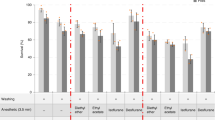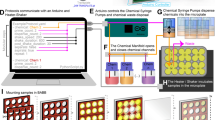Abstract
This immunofluorescence protocol can be used to assay cell morphology, cell positioning and subcellular localization of proteins in the fly eye at stages of development from early pupation to adult. The protocol includes the following procedures: collecting and developmentally staging Drosophila pupae, dissecting fly eyes at defined stages of development, immunostaining of retina and preparing visual system samples (i.e., retina and optic lobe) for confocal microscopy. It is supplemented with images of key dissection steps, guidelines for troubleshooting and examples of data obtained using these methods. Overall, this protocol takes up to 9 d to complete. The amount of hands-on time required on each day varies, ranging from 30 min to several hours depending on the number of stages and/or genotypes one wishes to study.
This is a preview of subscription content, access via your institution
Access options
Subscribe to this journal
Receive 12 print issues and online access
$259.00 per year
only $21.58 per issue
Buy this article
- Purchase on Springer Link
- Instant access to full article PDF
Prices may be subject to local taxes which are calculated during checkout



Similar content being viewed by others
References
Golic, K.G. & Lindquist, S. The FLP recombinase of yeast catalyzes site-specific recombination in the Drosophila genome. Cell 59, 499–509 (1989).
Brand, A.H. & Perrimon, N. Targeted gene expression as a means of altering cell fates and generating dominant phenotypes. Development 118, 401–415 (1993).
Carpenter, A.E. & Sabatini, D.M. Systematic genome-wide screens of gene function. Nat. Rev. Genetics 5, 11–22 (2004).
National Institute of Genetics (NJG), http://shigen.lab.nig.ac.jp/fly/nigfly (2006).
Institute of Molecular Biotechnology of the Austrian Academy of Sciences, Drosophila RNAi Group, http://www.imba.oeaw.ac.at/ (2006).
Ready, D.F., Hanson, T.E. & Benzer, S. Development of the Drosophila retina, a neurocrystalline lattice. Dev. Biol. 53, 217–240 (1976).
Ready, D.F. Drosophila compound eye morphogenesis: Blind mechanical engineers?. In Results and Problems in Cell Differentiation, Volume Drosophila Eye Development (ed. Moses, K.) 191–204 (Springer-Verlag, Berlin, Heidelberg, New York, 2002).
Pichaud, F. & Desplan, C. Cell biology: a new view of photoreceptors. Nature 416, 139–140 (2002).
Lee, T. & Luo, L. Mosaic analysis with a repressible cell marker (MARCM) for Drosophila neural development. Trends Neurosci. 24, 251–254 (2001).
Newsome, T.P., Åsling, B. & Dickson, B.J. Analysis of Drosophila photoreceptor axon guidance in eye-specific mosaics. Development 127, 851–860 (2000).
Stowers, R.S. & Schwarz, T.L. A genetic method for generating Drosophila eyes composed exclusively of mitotic clones of a single genotype. Genetics 152, 1631–1639 (1999).
Nam, S.C. & Choi, K.W. Interaction of Par-6 and Crumbs complexes is essential for photoreceptor morphogenesis in Drosophila. Development 130, 4363–4372 (2003).
Hong, Y., Ackerman, L., Jan, L.Y. & Jan, Y.N. Distinct roles of Bazooka and Stardust in the specification of Drosophila photoreceptor membrane architecture. Proc. Natl. Acad. Sci. USA 100, 12712–12717 (2003).
Pellikka, M, et al. Crumbs, the Drosophila homologue of human CRB1/RP12, is essential for photoreceptor morphogenesis. Nature 416, 143–149 (2002).
Izaddoost, S., Nam, S.C., Bhat, M.A., Bellen, H.J. & Choi, K.W. Drosophila Crumbs is a positional cue in photoreceptor adherens junctions and rhabdomeres. Nature 416, 178–183 (2002).
Karagiosis, S.A. & Ready, D.F. Moesin contributes an essential structural role in Drosophila photoreceptor morphogenesis. Development 131, 725–732 (2004).
Pinal, N., Goberdhan, D., Collinson, L., Fujita, Y., Cox, I., Wilson, C. & Pichaud, F. Regulated and polarized accumulation of PtdIns(3,4,5)P3 is essential for morphogenesis of the apical membrane in photoreceptor epithelial cells. Curr. Biol. 16, 140–149 (2006).
Sullivan, W., Ashburner, M. & Hawley, R.S. Drosophila Protocols. Cold Spring Harbor Press, Cold Spring Harbor, NY.
Satoh, A.K. & Ready, D.F. Arrestin1 mediates light-dependent rhodopsin endocytosis and cell survival. Curr. Biol. 19, 1722–1733 (2005).
Rossner, M. & Yamada, K.M. What's in a picture? The temptation of image manipulation. J. Cell Biol. 166, 11–15 (2004).
Acknowledgements
The authors would like to thank Donald Ready (Purdue University), who has pioneered the development of the protocols and the operating mode described in this manuscript. We would also like to thank the Pichaud lab for comments and suggestions about the manuscript. R.F.W. is the recipient of a National Cancer Institute of Canada Post-PhD Research Fellowship. This work is funded by an MRC Career Track Award to F.P.
Author information
Authors and Affiliations
Corresponding author
Ethics declarations
Competing interests
The authors declare no competing financial interests.
Rights and permissions
About this article
Cite this article
Walther, R., Pichaud, F. Immunofluorescent staining and imaging of the pupal and adult Drosophila visual system. Nat Protoc 1, 2635–2642 (2006). https://doi.org/10.1038/nprot.2006.379
Published:
Issue Date:
DOI: https://doi.org/10.1038/nprot.2006.379
This article is cited by
-
An apical MRCK-driven morphogenetic pathway controls epithelial polarity
Nature Cell Biology (2017)
-
Imaging the Drosophila retina: zwitterionic buffers PIPES and HEPES induce morphological artifacts in tissue fixation
BMC Developmental Biology (2015)
Comments
By submitting a comment you agree to abide by our Terms and Community Guidelines. If you find something abusive or that does not comply with our terms or guidelines please flag it as inappropriate.



